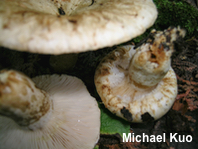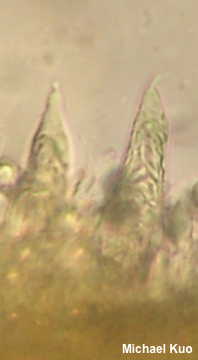| Major Groups > Gilled Mushrooms > Pale-Spored > Milky Caps > Lactarius olivinus |

|
[ Basidiomycota > Russulales > Russulaceae > Lactarius . . . ] Lactarius olivinus by Michael Kuo, 24 January 2024 This European milky cap is a mycorrhizal associate of spruce trees, and is found in northern and montane regions. The identifying features of Lactarius olivinus include its yellowing milk, the lack of concentric color zones on the cap, the presence (at least in youth) of brown fibrils that loosely form triangular aggregations, the spruce habitat, and, under the microscope, large and prominent macrocystidia. Lactarius olivinus, or something very like it, is apparently also present in montane and northern North America. The collection featured here was made in northern Michigan under white spruce (my apologies for the terrible photo; the collection was made 20 years ago, in a freezing cold cedar bog in September when I was in a hurry and still learning to use my first digital camera)—and a Montana collection made under Engelmann spruce is featured in Barge & Cripps (2018), who say their material "is morphologically close to the European L. olivinus except for the mild rather than acrid taste." The researchers add that "[m]olecularly, and ecologically, it is also close, [sic] however we refrain from calling it that species until more collections are examined and compared with European material" (41–42). The North American version of Lactarius olivinus has sometimes been featured in our continent's literature as Lactarius scrobiculatus var. canadensis—but this taxon is poorly defined and appears to "hold" several distinct entities (Hesler & Smith's original description contains at least three, according to Kytövuori 1984). Methven (1985, 1997) applied the varietal name canadensis to a West-Coast taxon that is yellow to dull orange and lacks the aggregations of brown fibrils, but later (2013) wrote that our continent's scrobiculatus-like mushrooms "need to be re-examined and revaluated." Description: Ecology: Mycorrhizal with spruces; growing alone or gregariously; late summer and fall; originally described from Sweden (Kytövuori 1984); distributed in northern and montane Europe; reported here from northern Michigan and in Barge & Cripps (2018) from Montana. The illustrated and described collection is from Michigan. Cap: 5–15 cm; convex with an inrolled and bearded margin when young, becoming shallowly vase-shaped, with the margin uplifted and smoother; sticky when young, but soon dry; covered with brownish to brown fibrils that are often aggregated into triangular shapes; whitish at first, becoming olive buff or yellowish in age; without concentric zones of color. Gills: Beginning to run down the stem; close; short-gills frequent; whitish. Stem: 2–5 cm long; 1–1.5 cm thick; tapered to the base; bald; with shallow, yellowish to brownish potholes; colored like the cap; hollowing with age; basal mycelium white. Flesh: Whitish; firm; stained yellow by the milk when sliced. Milk: White as exuded but quickly yellow. Odor and Taste: Odor not distinctive; taste somewhat peppery-acrid. Chemical Reactions: KOH on cap surface negative to pale orange. Microscopic Features: Spores 7.5–10 x 5.5–7.5 µm; ellipsoid or occasionally subglobose; ornamentation consisting of amyloid ridges and warts up to 0.5 µm high, forming broken reticula. Hymenial macrocystidia to about 80 µm long; fusiform, occasionally with an apical constriction; smooth; hyaline in KOH. Pileipellis an ixocutis; yellowish in KOH. REFERENCES: I. Kytövuori, 1984. (Hesler & Smith, 1979; Methven, 1985; Methven, 1997; Basso, 1999; Heilmann-Clausen et al., 2000; McNeil, 2006; Methven, 2013; Barge & Cripps, 2016; Verbeken & Vesterholt, 2018.) Herb. Kuo 09120405. This site contains no information about the edibility or toxicity of mushrooms. |
© MushroomExpert.Com |
|
Cite this page as: Kuo, M. (2024, January). Lactarius olivinus. Retrieved from the MushroomExpert.Com Web site: http://www.mushroomexpert.com/lactarius_olivinus.html |


